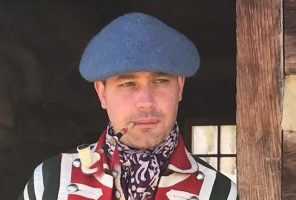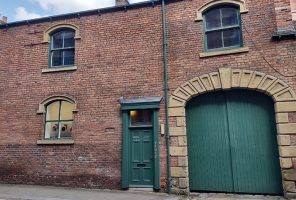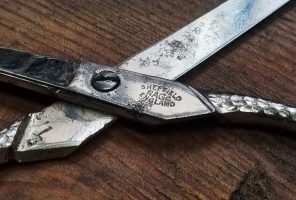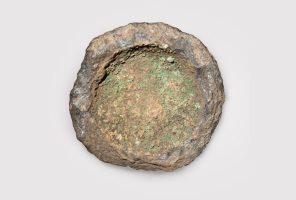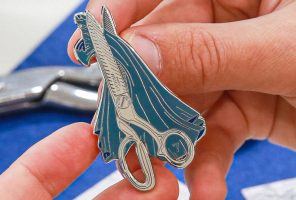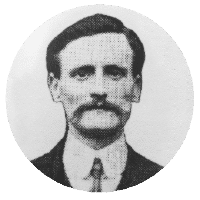
Han came to his craft of jeans-making the same way he now arrives at a finished pair of jeans: slowly.
He started in the eighties as a presser. Through ironing and QCing garments, he learnt the best temperature and treatment for each material, and how to spot the tiniest imperfections in a garment. He became a pattern cutter, a garment technologist – and by the age of 25, a factory owner.
After running a factory in London for ten years, Han upped sticks to work instead with producers in the Far East, which supplied British high-street brands including Marks & Spencer. His relationship with the fashion trade soured.
“A sense of disconnection happened,” Han explains.
“It wasn’t about the skills, or the craft. It was about saving on price, first with cheap labour, and once you settle in that country you try to achieve it with the materials.”
Disillusioned, Han left the industry just before the Great Recession, and then spent five years managing a fine dining restaurant. Haute cuisine, especially its investment in quality ingredients and local suppliers, offered relief from the corner-cutting and cut-throat culture of fast fashion.
But before long, Han pined for the creative buzz of garment-making. He would give fashion another chance – but this time, with a renewed focus on community values and sustainable sourcing. In 2016, Han founded Blackhorse Lane Ateliers, at an iconic Walthamstow factory building with a distinctive saw-toothed roof. Here, he would assemble a team of artisans to craft denim jeans of exceptional style, quality and ethical character.



A BLANK CANVAS
The BLA atelier is a vibrant workplace peopled by denim makers, tailors, designers and team members focused on the commercial side of the business. No two days are the same.
“Because you work with fabric, and with people and patterns and machinery, every day you have a creative challenge to find solutions to problems,” says Han.
“For example, denim fabric can have a higher or lower level of shrinkage because it comes from a certain part of the world. If you get cotton from the States, it’s got a different shrinkage from year-to-year than, let’s say, something from Central Asia, or Turkey or Egypt.”
BLA makes a kaleidoscopic range of denim jeans, jackets, tops, trousers and chinos. The variety is partially a reflection of problem-solving with materials – but it’s also about creativity.
“Even though most jeans look, on the face of it, like five-pocket jeans, there are hundreds of different shapes, from low-rise to medium-rise to back-rise; the size of the pockets can be different; the decision-making on the fabric is different, and also we are purists about working with rigid and raw denim,” says Han.
“If you go into washing, laundering the fabric, it becomes a really blank canvas, and you could do one-million versions of different washes.”
MADE TO LAST
Whereas many high street jeans will start to fall apart after a year or less, Han wants his jeans to be something that the wearer has a relationship with for many years. If you own a pair of BLA jeans and you’d like to test this concept, check the pockets.
“We use pocketing fabric that’s nearly 13 oz – so that’s indestructible pocketing. If you look at Levi’s pocketing, that’s 6 oz, so when you have Levi’s jeans, or any other jeans on the market, and you put change or keys in the pocket, within one year it goes,” says Han.
“With our pocketing it lasts a lifetime. So those little details prolong the lifecycle of the jeans.”
Many of BLA’s jeans have a wide leg. This, too, extends their lifespan, as the flaring allows for years’ worth of gradual shrinkage.
While attention to detail gives BLA jeans their longevity, traditional techniques elevate their quality further. Han explains:
“Because of demand, modern jeans-makers innovated new machinery to make production faster. There’s one technique called overlocking, where if you open your jeans, you’ll see there are unfinished edges tucked into three or four sets of different threads. This prevents fraying, but it also creates ugliness.
“At BLA, we went back and looked at the patented stitching techniques from 150 years ago in the U.S., when they didn’t have the new machinery. For example, we use a stitching technique called ‘French seam’, where you do a seam to the edges, and then you hide the unfinished edge and do another seam.”
Hand-crafting imbues BLA’s jeans with elegance – and also makes their manufacture much slower. Whereas a pair of Levi’s 501s can be made in 13-16 minutes, according to Han, BLA jeans are crafted in about 4-and-a-half hours.




CRAFT JEANS FOR A CRAFT NATION
Han Ates is not your average industrialist. Whenever viable, BLA’s materials are sourced sustainably. The cotton is organic, the denim is woven relatively nearby in Europe, and the brand grows its own indigo on an allotment near the factory. Customers are offered lifetime repairs on their garments, although if they follow BLA’s guidance on long-term care, this may not be necessary.
While BLA’s approach is forward-thinking, Han is acutely aware of the company’s place within the centuries-old tradition of British craft.
“As a nation, the UK is a craft nation, and we should look after our craftsmakers a bit more lovingly,” says Han.
“For me, craft production is very important for any city, town, or country. It creates a sense of continuity, the passing-on of knowhow and a sense of connectivity with the past,” he says.
“You can get mass production jeans – 13-minute jeans – or you can get 4-hour jeans. There’s a place for both, and they represent different values.
“Craft production is something we need to nurture every day in our lives.”


